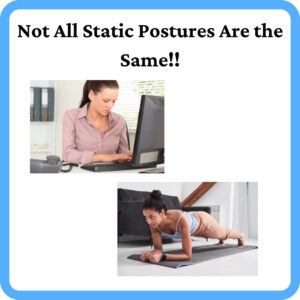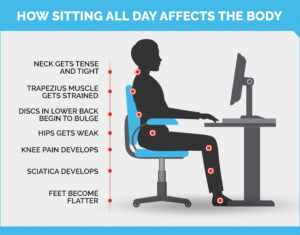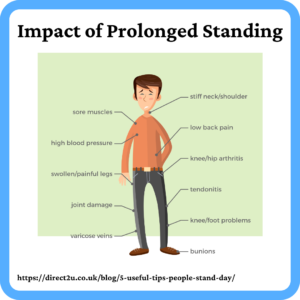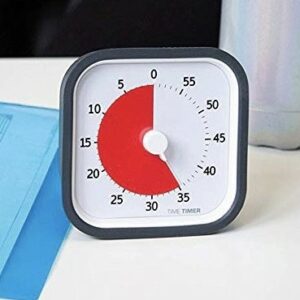When it comes to musculoskeletal discomfort, appropriate postures and equipment in the workplace are crucial to reducing the risk. However, even with the most suitable equipment and neutral supported postures, musculoskeletal discomfort and injury can, and likely will, occur if postures are maintained for too long.

This you!?
In this post, I will describe what is meant by static postures, the impact static postures can have on our musculoskeletal health and steps that can be taken to reduce the risks.
What Are Static Postures?
Static postures, also known as static loading, refers to physical exertion in a fixed position or posture, such as sitting, standing or sleeping. The limbs are held in position by the various muscle groups working together to counteract the force of gravity, keeping you in the fixed position you want to be in.
The time that a static posture can be maintained before discomfort develops varies based on the posture, muscular effort required to maintain posture, associated loads and persons’ physical condition. An easy comparison is how long you can comfortably remain seated at your workstation vs how long you can comfortably hold a yourself in the plank position, both static postures but with differing energy requirements, active muscle groups and load.

How Can Static Postures Negatively Impact Our Musculoskeletal Health?
I feel that I should start this section with a side note – static postures are not bad! They are a necessary part of our functionality. It would not be practical, or safe, for use to be constantly mobile.
It is not the posture that is the main issue when it comes to risks associated with static postures, it is the frequency and duration that these postures are maintained.
Static postures require continuous contraction of the muscles required to maintain that position. This continuous contraction, or loading, in a fixed position results in reduce blood flow in the muscles, meaning that waste products cannot be removed effectively and oxygen and nutrients cannot be distributed efficiently. This causes fatigue and discomfort in the musculoskeletal system, which can contribute to adverse postures and those aches and pains you feel after a long day at work!
As sitting and standing are the most common static workplace postures that I encounter, I will discuss the impact on our health separately.
What is Prolonged Static Sitting?
According to the European Agency for Safety and Health at Work, static sitting becomes a prolonged sedentary behaviour if the position is held for 2 hours continuously as it required low energy consumption, is seated and requires physical exertion to maintain the position.
Prolonged sitting is a feature of many roles, including those based at service desks, control rooms, laboratories, production / packing lines, air traffic control rooms, vehicles and offices. As office tasks become more DSE orientation and digitised, the natural opportunity for posture changes decreases and the time spent seated at the workstation increases.
The Impact of Prolonged Static Sitting on Our Health
Low Back Issues
There are many ways prolonged static sitting can impact our lower back and it can often be a combination of the below factors that can cause worker discomfort.
Sitting increases the pressure on the intervertebral discs in the lower back, as they are being compressed from above and below. The level of pressure on the discs varies based on seated position, ranging from 140% of standing pressure when seated upright to 190% of standing pressure when leaning forward. Prolonged sitting also reduces the pumping action required to provide the discs with nutrients and reduce degenerative changes.
Sitting also places increased loads on the back muscles and tendons and strains the ligaments.
Sitting causes imbalances in our core stabiliser muscles due to the overuse of some muscles, but low activation of others. The upper back muscles can weaken while the chest muscles tighten. The abdominals can weaken while the lower back muscles tighten. The glutes can weaken and the hamstrings and hip flexors tighten. These imbalances can affect alignment, posture and cause pain in the lower back.
As prolonged static sitting is a sedentary behaviour, characterised by low energy consumption, it increases the risk that the energy demand for the back muscular system is below what is required to maintain a healthy system. This low metabolic demand, with reduced circulation can lead to stiffness, muscular degeneration and osteoporosis.
Neck and Shoulder Discomfort
Adverse postures can increase strain on the muscles of the neck and shoulders. Prolonged adverse postures can increase pressure on the blood vessels, reducing blood flow to the muscles and also the muscles of the arms, increasing the risk of neck, shoulder and upper limb discomfort.
Lower Limb Discomfort
Prolonged sitting can increase the risk of lower limb discomfort, stiffness on standing, swelling, tingling or pins and needles associated with reduced blood flow.
Cardiovascular Issues and Diabetes
Prolonged static sitting reduces the activities of some of our large muscle groups, including the leg muscles, glutes and abdominals. This decrease in activity can increase the concentration of fat in and around these muscles and reduce our sensitivity to insulin. These factors can contribute to the risk of developing cardiovascular disease and / or Type II diabetes.

What is Prolonged Standing?
Prolonged standing can be defined as standing for 1 hour continuously or standing for 4 hours per day. Prolonged standing is a feature of roles in the industrial, educational, healthcare and services sectors, where tasks are carried out in the standing position due to workplace design, tasks requirements or company culture.
The Impact of Prolonged Static Standing on Musculoskeletal Health
The most common areas of discomfort associated with prolonged standing postures are the feet, legs, hips and lower back.
Lower Limbs Issues
Due to the decreased blood flow associated with static postures, more so to the lower limbs when standing, the effects can include:
- Lower limb fatigue
- Lower limb discomfort
- Varicose veins
- Swelling in legs and feet
Degenerative damage and joint pain to the lower limbs can occur due to lack of mobilisation of the joints.
Increased pressure on the lower limb joints from prolonged standing can decrease lubrication and cushioning in the synovial joints, causing tears to occur, resulting in pain when moving the limbs.
Prolonged standing can also result in plantar fasciitis, heel spurs, bunions and corns, Achilles tendonitis.
Low Back Issues
Prolonged standing can be associated with an increased curve in the lower back due to the postural position of the pelvis. This puts pressure on the muscles, discs, tendons and ligaments which can cause the low back muscles to tighten.
Neck and Shoulder Discomfort
Similar to prolonged sitting, standing postures in the workplace can incorporate adverse postures of the neck and shoulders. Prolonged adverse postures can increase pressure on the blood vessels, reducing blood flow to the muscles and also the muscles of the arms, increasing the risk of neck, shoulder and upper limb discomfort.
Cardiovascular Issues
Prolonged static standing can cause blood to pool in the lower limbs, due to reduced circulation and blood flow. This increases pressure on the veins in the legs and increases oxidative stress and inflammation.

How Can You Reduce the Impact and Risk Associated with Prolonged Static Postures?
If you are an employer, you are responsible for ensuring that employees can vary positions, postures and tasks during the work day to reduce their exposure to prolonged static postures. Ensuring that the work area can be adjusted to suit each user can help reduce the adverse postures and strain while they are at the workstation.
EU-OSHA recommends that to reduce the risks associated with prolong static sitting, we should:
- Aim to spend <50% of the day sitting
- Avoid prolonged periods of siting, moving from this position every 20 – 30 minutes
- Always get up and move around for at least 10 minutes if you have been sitting for 2 hours
- Aim for a maximum of 5 hours total sitting when at work
- Alternate frequently at work between sitting, standing and walking
When it comes to prolonged static standing, I feel this is more of a risk in the workplace compared to during leisure time as if we get tired doing tasks outside of the workplace, we are more likely to sit down to alleviate discomfort.
If tasks must be completed in the standing position, ensure that:
- The flooring is suitable, eg wood, cork, carpet or rubber. If the flooring is metal or concrete, add matting to the work area, such as anti-fatigue matting.
- Ensure you are wearing, or you provide, appropriate supportive footwear.
- Surfaces should be height adjustable
- Workplace should be designed to reduce twisting and bending when working in the standing position
I usually recommend avoiding static posture of more than 45 minutes duration. However, standing positions can be maintained for longer, as long as they are dynamic and not fixed. Standing during calls and virtual meetings can be a great way of getting more movement into the day for DSE based workers. Even moving with 1 sqm of space around your workstation can reduce the risks associated with static standing.
Static standing is not the solution to static sitting and vice versa. They are not opposites.
The key is regular movement to allow the muscles to be activated and rested at regular intervals during the day and to promote optimum blood flow and oxygen supply to the muscles and other organs.
Now I know that you all know that you should be moving more during the work day, especially if you are based at a DSE workstation workstation, but the reality of it is that most of use are too focused on our work tasks to remember to move regularly. We have great intentions but do not often follow through.
What I have found over the years to help encourage frequent changes of posture is moving the mental load from internal to external. Downloading a break reminder app or a productivity app on to your phone, or using an external productivity clock or timer allows you to focus on your tasks with external reminders to break your focus from the screen and tasks and encourage mobility and movement.

Sources
Musculoskeletal Disorders and Prolonged Static Standing – Nicolien de Langen & Kees Peereboom, OSHWiki
Musculoskeletal Disorders and Prolonged Static Sitting – Nicolien de Langen & Kees Peereboom, OSHWiki
Promoting Moving and Exercise at Work to Avoid Prolonged Standing and Sitting – Nicolien de Langen & Kees Peereboom, OSHWiki
Prolonged Static Sitting at Work – Nicolien de Langen & Kees Peereboom, OSHWiki


